Tomatillos Unwrapped: The Secret Star of Mexican Cuisine
0
Updated Apr 16, 2024, Published Oct 27, 2023
This post may contain affiliate links. Please read our disclosure policy.
Picture a little green orb wrapped in a delicate, papery husk, holding within its walls a flavor so distinct and tantalizingly zesty that it has woven its way into the very fabric of a nation’s culinary history. No, it’s not the latest overpriced “superfood” being hawked at health food stores; it’s the humble Tomatillo — a staple in Mexican cuisine.

Table of Contents
- What are Tomatillos?
- What’s the Difference Between Tomatillos & Tomatoes?
- What do Tomatillos Taste Like?
- How to Pick Tomatillos at the Store
- How to Prepare Tomatillos
- How to Cook Tomatillos
- How to Store Tomatillos
- Benefits of Tomatillos
- Frequently Asked Questions
- How To Use Tomatillos — My Favorite Recipes With Tomatillos
If you’ve ever enthusiastically devoured a bowl of tangy homemade salsa verde or a plate of chilaquiles verde and wondered about the secret ingredient that gives these dishes their unique punch, congratulations! You’ve already met the tomatillo.
Join me as we unravel the magic of these vibrant culinary gems, venturing beyond their enigmatic exterior to explore their rich history, distinctive taste, and indispensable role in traditional Mexican cooking. Together, we’ll discover the art of selecting the perfect tomatillos as well as mastering the simple process of preparing and cooking them. Ready for a flavor fiesta? ¡Vamos a la cocina! 🍅🥳🌮

What are Tomatillos?
Originating from Mexico, tomatillos are the stars behind many of the dishes we associate with Mexican cuisine, especially those zesty green salsas and sauces. As you might expect from their tomato-like appearance, these vibrant green orbs belong to the same nightshade family and are most closely related to gooseberries.
Encased in a thin, parchment-like husk, each tomatillo bears a striking, bright green color that sometimes matures to a soft yellow. They’re slightly tart, with a hint of lemony freshness and an earthy undertone — a distinct flavor profile that sets them apart from regular tomatoes.
So, next time you stumble upon these green wonders in your local store, remember you’re looking at centuries of Mexican culinary history wrapped up in a tiny, tasty package!
What’s the Difference Between Tomatillos & Tomatoes?
While they might seem like siblings at first glance, tomatillos and tomatoes are more like cousins, each with their own delectable secrets to share. Here are some primary differences:
Tomatillos:
These green (or sometimes yellow) orbs burst with a bright, tangy flavor that leans more towards citrusy zest. They’ve got a little tart kick, balanced by subtle sweetness, which makes them the go-to ingredient for a lively punch in dishes.
Typically found in Mexican and Central American cuisine, they’re the backbone of salsas verdes and the tangy sauce for my green pulled pork enchiladas. You can roast, blend, or even eat them raw in salads!
Tomatillos also come wrapped in a papery husk, which is actually the calyx growing as the fruit matures inside. It’s like nature’s own little gift wrapping! Biologically, tomatillos are closer to ground cherries or gooseberries because of their husked nature.
Tomatoes:
Juicy and versatile, tomatoes have a sweet and slightly acidic taste. They can range from super sweet (like those darling cherry tomatoes) to rich and umami-packed (like a ripe heirloom tomato).
From Italian marinara sauces, Spanish gazpachos, to the humble sandwich slice—tomatoes fit almost anywhere. They can be roasted, pureed, sun-dried, or simply plucked and eaten fresh.
Unlike their husky friends, tomatoes grow proudly exposed, displaying their radiant red, yellow, purple, or even green hues. They’ve been cultivated and bred in countless varieties, each with its own flavor profile and culinary use.
So, whether you’re whipping up a zesty salsa verde or a rich spaghetti sauce, remember: It’s all in the family!

What do Tomatillos Taste Like?
Tomatillos exude a crisp, herbaceous note that feels invigorating to the palate. Their taste has an underlying grassy freshness, complemented by a mild fruitiness. While their tang is ever-present, it’s never overwhelmingly sour.
Instead, it offers a refreshing zest, reminiscent of a fusion between a tart apple and a zingy lime. Their texture, especially when fresh, adds to this experience with a satisfying crunch that’s not quite as juicy as its tomato cousin.
Here are some tomatillo-centric dishes you might be familiar with to help remind you of their flavor:
- Salsa Verde: Arguably the most iconic use of the tomatillo, this green sauce is a mix of roasted or boiled tomatillos, chiles, onions, and cilantro. Drizzle it over tacos or use it as a vibrant dipping sauce, and let the flavors sing!
- Chilaquiles Verdes: Imagine crispy tortilla chips softened in a zesty tomatillo sauce, then adorned with crumbled queso fresco, crema, and maybe some shredded chicken. It’s a breakfast dish that’ll make you jump out of bed!
- Pozole Verde: A hearty soup where hominy (dried maize kernels) is bathed in a rich tomatillo broth, often accompanied by chicken or pork. It’s a comforting bowl of warmth, with tomatillos elevating every spoonful.
- Turkey Enchiladas Verdes: Soft tortillas rolled with cheese or meat fillings, then smothered in a tomatillo sauce and baked to perfection. The result? A plate that’s dripping in both flavor and history.
So, the next time you take a bite of a Mexican dish tinged with green, tangy goodness, you’ll know that the humble tomatillo is working its magic!
How to Pick Tomatillos at the Store
With these tips in your culinary toolkit, you’ll be picking the best tomatillos the store has to offer:
- Inspect the Husk: The first thing you’ll notice about tomatillos is their signature papery husk. Look for ones that fit snugly around the fruit, almost like a tight little jacket. A tight husk usually indicates a fresh tomatillo inside.
- Feel the Firmness: Give your tomatillo a gentle squeeze (but let’s be gentle, we don’t want to bruise these beauties!). A prime tomatillo will feel firm, similar to a ripe tomato. If it’s too squishy, it might be past its prime.
- Peek Inside: Don’t be shy! Pull back the husk just a tad to get a glimpse of the fruit like you would when buying ears of corn. You’re looking for a vibrant green color. While some slight variations in green are fine (and can be a touch yellowish), avoid those with noticeable dark or soft spots.
- Size Matters… Sometimes: Tomatillos come in various sizes, from small marbles to lacrosse ball-sized wonders. While size doesn’t always determine taste, it can affect cooking time. So, think about how you’ll use them. If you’re making a salsa and need them to roast quickly, perhaps smaller ones are your best bet!
- Fresh is Best: As with most produce, the fresher, the better. Tomatillos should be free of wrinkles and feel plump inside their husks.
How to Prepare Tomatillos
Unlocking the magic of tomatillos begins long before they hit the pan. Proper preparation is key to ensuring that the rich, zesty flavors of these vibrant fruits shine through in every dish. Let’s dive into the simple yet essential steps to get your tomatillos ready for their gastronomic debut!
Step 1: How To Peel Tomatillos
- Begin by holding the tomatillo at the base, where it connects to the husk.
- Gently peel away the outer papery layer, which should come off with ease.
- As you peel, you might notice some of the husk is adhered more closely to the fruit; no worries, a gentle tug should do the trick.
Step 2: Washing the Tomatillos
- Once you’ve de-husked your tomatillos, you’ll often find a slightly sticky, resin-like substance on the skin. This is natural and perfectly fine!
- Place your tomatillos in a colander or a mesh sieve.
- Rinse them under cool running water, giving each one a gentle rub with your fingers to remove any stickiness and residue.
- Give them a good shake or pat dry with a paper towel to remove excess water.
Step 3: How to Cut Tomatillos:
- Place your tomatillo on a cutting board with the stem side facing up.
- Using a sharp knife, slice off the small stem at the top.
- Cut the tomatillo in half horizontally, revealing its juicy, seed-filled interior.
- From here, you can slice them into wedges or chop them into smaller pieces, depending on your recipe’s requirements. If blending for a salsa or sauce, halving them might be sufficient.
How to Cook Tomatillos
Tomatillos are versatile wonders in the kitchen, adapting beautifully to a medley of cooking techniques. While their raw, herbaceous punch can jazz up any fresh salsa or salad, applying heat transforms them, mellowing their tang and deepening their flavor profile.

Whether you’re looking to infuse your dishes with a smoky undertone, a roasted richness, or a soft, melded texture, there’s a method to suit every culinary vision:
How to Boil Tomatillos
- Fill a saucepan with enough water to cover the tomatillos and bring it to a boil.
- Add your prepared whole or halved tomatillos.
- Let them simmer for about 5-7 minutes, or until they change from a vibrant green to a more muted, olive hue.
- Once done, remove them with a slotted spoon. Now they’re ready for blending into a velvety green sauce or soup!

How to Roast Tomatillos
- Preheat your grill or comal to medium-high heat.
- Cook for about 5-7 minutes, turning occasionally, until they’re charred and blistered on all sides.
- Roasted tomatillos offer a delightful smoky flavor, an excellent addition to summer BBQ dishes or to add depth to your traditional recipes.
- Roasting tomatillos gives them a caramelized sweetness, perfect for rich salsas.
How to Store Tomatillos
Proper storage ensures tomatillos maintain their unique flavors and textures, both in their natural state and once they’ve felt the heat!
Raw Tomatillos
If you’re not planning to use them immediately, you can store raw tomatillos in their husks. Place them in a paper bag or a perforated plastic bag, and keep them in the vegetable crisper drawer of your refrigerator. This method will keep them fresh for up to two weeks.
Once you’ve removed the husks and rinsed the raw tomatillos, ensure they’re dry before storing. Moisture is an enemy here, as it can accelerate spoilage. Lay them out on a tray or dish, let them air dry, then store them in a sealed plastic bag in the refrigerator. They’ll be good for about a week.
Cooked Tomatillos
Whether you’ve boiled, roasted, or grilled them, always let your cooked tomatillos come to room temperature before you transfer them to an airtight container. Under proper conditions, cooked tomatillos can be stored in the refrigerator for up to 5 days. Hooray for meal preppers everywhere!
If you’ve cooked up more tomatillos than you can use immediately, you can freeze them for the long haul. Once cooled, spread them on a baking sheet to freeze individually. Once frozen, transfer them into airtight containers or heavy-duty freezer bags. They can be stored in the freezer for up to 12 months. When you’re ready to use them, simply defrost as much as you need in the fridge.
Benefits of Tomatillos
These green gems are more than just a tasty ingredient in our favorite Mexican dishes; they’re little powerhouses of health benefits. First off, they’re packed with a good dose of vitamin C, which is fabulous for our immune system and for keeping our skin radiant. Plus, they sprinkle in some essential minerals like potassium, magnesium, and manganese.
For anyone watching their waistline (or just trying to eat healthily), you’re in luck. Tomatillos are flavorful but low in calories, so you can add zesty goodness without any guilt. And if you’ve ever felt a bit, well, backed up, the dietary fiber in the fruit can aid digestion.
Oh, and that vibrant green color isn’t just for show. It hints at the antioxidants they contain – like chlorophyll! – which help combat those pesky free radicals that cause oxidative stress in our bodies. Speaking of colors and sight, tomatillos are also buddies for our eyes thanks to phytochemicals like lutein and zeaxanthin.
Lastly, for those of us who want to keep our bones strong and dance into our later years, tomatillos come to the rescue again with a dose of vitamin K, which is instrumental in bone health.
So, next time you’re whipping up a dish with tomatillos, remember you’re not just treating your tastebuds but giving your body a little health hug too! 🌱🍴✨
Frequently Asked Questions
Certainly! While tomatillos and tomatoes are different (read above for a refresher), you can eat tomatillos raw just like tomatoes. However, tomatillos have a more tart and zesty flavor compared to the sweeter taste of tomatoes. They’re great sliced in salads, blended into fresh salsas, or even nibbled on their own. Just remember to remove the husk and give them a rinse first!
While tomatillos and green tomatoes may share a similar color and both have a certain tanginess, they don’t taste the same. Tomatillos have a unique, zesty, and slightly herbal flavor, while green tomatoes are more acidic and carry the familiar taste of tomatoes, albeit less sweet and more tart. Each brings its distinct profile to dishes, so they’re not typically interchangeable in recipes.
I keep them on my countertop at room temperature for a couple of days, but tomatillos should be refrigerated if you’re not using them immediately. Storing them in the refrigerator, especially in the vegetable crisper drawer, can help prolong their freshness.
Yes, it’s natural for tomatillos to have a sticky residue on their surface once you remove the husk. This sticky substance is a natural deterrent against insects in the wild. Simply rinsing the de-husked tomatillos under water will usually remove most of the stickiness before you use them in your dishes.
Tomatillos should be firm to the touch, similar to a ripe tomato, but not overly hard. If they’re too soft or show signs of wrinkling, they might be overripe or starting to spoil. When choosing tomatillos, look for those that are firm with a tight-fitting husk for the best quality and flavor.
Tomatillos are typically green when they are best for culinary use, offering a tangy and zesty flavor. However, as they ripen further, they can turn yellow or even purple (though not really red). While yellow tomatillos are sweeter and can be eaten, the green ones are more commonly used in recipes for their characteristic tartness.
Yes, they’re related to one another and are both part of the nightshade family, but they are two distinct fruits. See above for more details!
You can totally eat tomatillos raw, but some recipes might call for them to be cooked to change their flavor profile a bit. Just follow the recipe instructions for the best results.
Nope! They have a tangy and zesty flavor. However, they are often paired with spicy ingredients in salsas and sauces, which can give the overall dish a spicy kick.
Yes! In fact, freezing tomatillos is a great way to store your haul. Just make sure to cook and cool them first as advised above in the “How to Store Tomatillos” section.
Tomatillos grow on bushy plants, similar to tomatoes, but are enclosed in a papery husk or lantern-like structure. As the fruit matures, it fills out the husk, which often splits open when the tomatillo is ready for harvest.
The closest substitute for tomatillos, especially in salsas and sauces, is green tomatoes. They offer a similar tartness, though the flavor profile isn’t identical. Lime juice can be added to enhance the acidity if needed. However, it’s essential to note that while green tomatoes can mimic the tanginess, they won’t fully replicate the unique taste of tomatillos.












